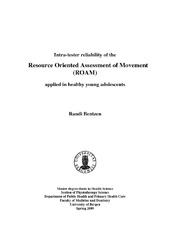Intra-tester reliability of the Resource Oriented Assessment of Movement (ROAM) applied in healthy young adolescents
Master thesis
Permanent lenke
https://hdl.handle.net/1956/7554Utgivelsesdato
2009-05-25Metadata
Vis full innførselSamlinger
Sammendrag
Background and purpose: With the knowledge of the Norwegian Global Physiotherapy Examination (GPE) method, an examination method based on psychosomatic physiotherapy with tests related to general aspects of respiration, movements, muscles, skin and a total pattern of tension, and with the experience of applying The Laban Movement Analysis in physiotherapy, the purpose of this study has been to develop an assessment instrument grounded on these methods, and to examine the intra-tester reliability of the instrument. Method: The instrument, The Resource Oriented Assessment of Movement (ROAM), consisting of an observation protocol, an assessment form, a manual for the analyses and scale for scoring, were constructed. The design of the study was an intra-tester reliability design conducted on analyses of observation of movements of young adolescents. 20 children, 10 girls and 10 boys, with a mean age of 12.5 years, were video-filmed. The observations were analysed by the same tester twice. Results: The relative intra-tester reliability and absolute intra-tester reliability were overall acceptable. The lowest scores were found in the domain of Effort, some of which were due to a lack of range in the scores of the fairly homogenous group of informants, and some were due to a measurement error by the researcher. The internal consistency of the ROAM was very good, and only a few items within the domain of Body, did not seem to measure what the scale was intended for. Conclusion: The reliability findings show that the ROAM could be a tool for further investigation of validity and application within physiotherapy. The study has given rise to a further discussion on the choice of the scoring scale and possibly further studies for a reduction in the number of items. Bakgrunn og hensikt: Med kunnskap om Global Fysioterapeutisk Muskelundersøkelse (GFM), en undersøkelse bygget på norsk psykomotorisk behandling til kartlegging av respirasjon, bevegelser, muskulatur og et totalt spenningsmønster, og med erfaring fra bruk av Laban Movement Analysis innen fysioterapi, har hensikten med studien vært å utvikle et instrument til undersøkelse av bevegelser med disse metodene som utgangspunkt. Videre har hensikten vært å undersøke intra-tester reliabilitet av instrumentet. Metode: Instrumentet, The Resource Oriented Assessment of Movement (ROAM), ble utviklet med en observasjonsprotokoll, et undersøkelses-formular og en manual for analyse med tilhørende skala for registrering av funn. Studien anvendte et intra-tester reliabilitets design, og ble utført ved observasjon av bevegelser hos barn. Materialet bestod av 20 barn, 10 jenter og 10 gutter, med en gjennomsnitts-alder på 12.5 år, som ble video-filmet. Observasjonene ble analysert to ganger av samme person. Resultat: Relativ intra-tester reliabilitet og absolutt intra-tester reliabilitet viste adekvate funn. De laveste funn fremkom innen området Effort, og enkelte av disse kunne begrunnes i manglende variasjon mellom skårene, på bakgrunn av homogenitet i materialet, men enkelte berodde på en målefeil utført av testeren. ROAMs interne konsistens var meget høy. Kun noen enkeltskårer innen området Body, viste ikke funn forenlig med testens intensjon. Konklusjon: Reliabilitetsfunnene viser at ROAM muligens kan være et instrument til videre studier av validitet og anvendelse innen faget fysioterapi. Studien gir grunnlag for videre diskusjon om valg av skårings-skala og videre studier for en eventuell reduksjon i antall variabler.
